
BLOG
Canine Distemper Shows Up in Birmingham – Know the Sign, Symptoms, and Treatment.
Merritt Milam | June 1, 2022
The good news…Wags does NOT have an outbreak of canine distemper! We make sure all dogs boarding and/or attending camp are vaccinated.
The bad news…canine distemper has shown up in the Birmingham area.

What is Canine Distemper and How Is It Spread?
Distemper is a paramyxovirus that affects the respiratory, gastrointestinal (GI), and nervous system of dogs in all life stages. While distemper is a highly contagious disease and potentially deadly, it’s also one of the most preventable. Dogs spread the virus through direct contact with an infected animal or object, airborne exposure, or through the placenta.
Aside from dogs, distemper is also a disease of wild animals like raccoons, wolfs, ferrets, skunks, and foxes. Pet owners should be careful their dogs do not encounter wild animals.
Canine Distemper Signs: Stage One
Dogs with distemper will usually first experience watery to pus-like discharge from their eyes, followed by fever, loss of appetite, and clear nasal discharge. Depending on the severity of the case, most dogs develop a fever approximately 3-to-6 days after being infected. The signs associated with distemper in dogs during the first stages of infection are:
• Fever
• Clear nasal discharge
• Purulent eye discharge
• Lethargy
• Anorexia
• Coughing
• Vomiting
• Diarrhea
• Pustular dermatitis (rarely)
• Inflammation of the brain and spinal cord

Risks associated with distemper relate to physical changes to the nose and paw areas. If a dog infected with distemper survives the initial stage of the illness, he may also develop hyperkeratosis of the paw pads and nose, which gives distemper the nickname “hard pad disease.” This distemper symptom causes the pads of a dog’s feet to harden and enlarge and is uncomfortable.
Canine Distemper Signs: Stage Two
As the disease progresses, some pets will have neurological signs as it attacks the central nervous system. These signs include:
• Head tilt
• Circling
• Partial or full paralysis
• Seizures
• Nystagmus (repetitive eye movements)
• Muscle twitching
• Convulsions with increased salivation and chewing motions
• Death
Treating Distemper

While there is no cure for canine distemper, veterinarians will provide supportive care for dogs who have been diagnosed with this disease. Supportive care is used to prevent dehydration and secondary infections. Vets will usually isolate infected dogs so the spread is contained. The survival rate will depend on the strain of the disease. Some cases can resolve in 10 days, while more severe cases may exhibit neurological symptoms for weeks or months.
Preventing Distemper in Dogs
The good news is that distemper is very preventable, provided dogs receive the full series of vaccinations. It is important dogs maintain distemper vaccinations throughout their life. Dogs should also stay away from wild animals and unvaccinated pets. Use caution if you socialize a new puppy or unvaccinated dog at a dog park or daycare where other dogs meet.
At Wags we take your pet’s health and happiness seriously. All pets are required to be up to date on their vaccinations if they are boarding or attending day care. We hope this information has been helpful. Check with your vet for full vaccination requirements along with additional safeguards to keep your pet safe and healthy.


